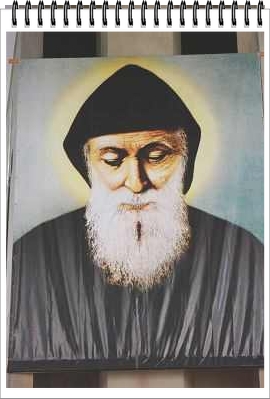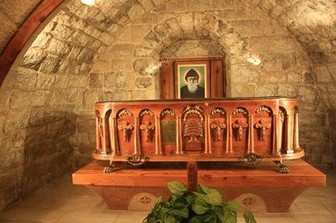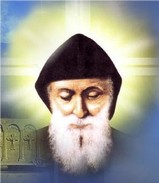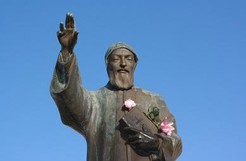Patrizia Cattaneo
Main menu:
St Charbel
SAINTS
CHARBEL MAKHLOUF
THE LEBANESE SAINT
WHO HAS BECOME A LEGEND

Visit ou website www.charbelfriends.com
Saint Charbel Makhlouf is one of the best known saints in the Middle East.
He arouses admiration and universal awe because of the extraordinary miracles and signs wrought through the power of his intercession.
He was born in 1828, the fifth child of poor parents Antuna and Brigida Makhlouf, who lived in the small hilltop town of Beqaakafra, 140 kilometers north of Beirut. He was christened Joseph, his parents being Catholics of the Maronite Rite. Their children grew up in a joyful atmosphere of mutual love which flowed from a life of daily prayer and hard work on the land. During this time Lebanon was under the rule of the Ottoman Empire.
When Joseph was three years old, his father died. To ensure her children's keep and education, Joseph's mother decided to remarry. She took as her husband an upright and devout deacon by the name of Ibrahim. At the age of fourteen, Joseph felt the call to the monastic way of life, but it was only in 1851 that he decided to enter the monastery in Maifuq. He applied for admission and there spent the first year of his novitiate. In his second year he moved to the monastery in Annaya, where, on November 1853, he took his preliminary vows and took the name of Charbel, after the Antiochian martyr of 107 A.D. He finished his theological studies and was ordained to the priesthood on July 23rd, 1859.
As a young priest in 1860, he was witness to the appalling massacre of over 20,000 Christians by Muslims and members of the Druse sect. Muslim troops murdered entire families of Christians without mercy, looting, plundering, and burning churches, convents, farms, and homes. Hundreds of refugees, hungry, wounded, and terrified by what had happened and might yet happen, sought shelter in the monastery of Annaya. Father Charbel rendered every possible assistance to the refugees, all the while praying, fasting, imposing severe penances upon himself, offering himself to God in a spirit of expiation for the crimes committed, and begging for God's mercy on persecutor and persecuted alike.
On February 15th, 1875, after spending seventeen years in the monastic community in Annaya, Father Charbel received permission to move to the hermitage of Saint Peter and Saint Paul, there to unite himself with Christ, through prayer, manual abor, and even stricter acts of self-denial. This tiny, isolated hermit (home to but three monks) stood 1,350 meters above sea-level. Charbelís cell was only six meters square. He always wore a hair-shirt under his habit and slept only a few hours every day. Once a day he ate very meager meals without meat. The Eucharist was the focal point of his life. After long preparation, he would say Holy Mass in the hermitage chapel, then remain there for two more hours of thanksgiving.
His cherished form of prayer was Adoration of the Blessed Sacrament. His daily round consisted of meditating on Holy Scripture, praying without cease, and working. In this way Charbel offered himself up to God, that God might purify his heart and free him of all evil inclinations and selfishness; in other words, He made him into a saint, such as Jesus desired. His fellow monks considered him a saint during his life-time, for they knew just how heroically he strove to imitate Jesus.
Only certain people are called to a way of life as rigorous as Charbelís; but Christ calls every one of us to holiness. Our purpose on earth is to grow in love, to attain heaven; that is, to love as Christ loves us, and to realize in our daily lives His greatest commandment "that you love one another even as I have loved you, that you also love one another "(Jn 13:34).
Father Charbel died on Christmas Eve of 1898, while celebrating mass. Outside, it was snowing hard, and a chill wind was blowing. All the roads to the hermitage were snowbound, and no one from the monastery could inform the local villagers of the hermitís death.
Yet a strange thing happened. That very day every local villager experienced an inner conviction that Father Charbel had been called to heaven. Young men set out with shovels to clear the snow, that they might reach the hermitage and carry the body to the monastery in Annaya. "We have lost a brilliant star that protected our Order, the Church, and all of Lebanon with its holiness" wrote the Prior. "Let us pray that God make Charbel our patron, who will watch over us and be our guide through the darkness of our earthly life".
On Christmas Day, Father Charbel was laid to rest in a communal grave in the monastery.
THE MYSTERY OF HIS BODY

Charbel's tomb at Annaya Monastery
The following night a mysterious brilliant light became visible across the entire valley. It continued to shine for forty-five nights. The event caused a great stir throughout the whole district. Thousands of Christians and Muslims came to the tomb to see this extraordinary phenomenon. Some managed to dig up the grave and help themselves to scraps of the saintís clothing and locks of his hair as relics. For reasons of safety the Maronite Patriarch decided to have the body brought to the monastery.
The grave was opened in the presence of a doctor and other official witnesses. Though covered with wet mud, the exhumed body was perfectly preserved. The body was then subjected to medical tests, which confirmed that it was free of any signs of decay; moreover, it gave off a wonderful aroma and a fluid of unknown origin (a mixture of plasma and blood). To this day, the fluid continued to seep out of the Saintís body till the day of his canonization, as a sign of Christ's healing power. Father Charbelís body was washed, dressed in fresh robes, laid in an open coffin, and placed in a room of the monastery closed to the public. Owing to the fluid constantly seeping out of the body, the monks had to change the Saintís robes every two weeks.
It was only on My 24th, 1927 that the mortal remains of the hermit were laid in a metal coffin and removed to a marble tomb in the monastery church. In 1950, a mysterious fluid began to flow in profusion from the tomb. The Maronite Patriarch had the tomb opened and the body, exhumed. This was performed in the presence of a medical commission, church representatives, and city officials. The Saint looked in a state if perfect preservation. In fact, the fluid that constantly seeped from his body had corroded the metal coffin and eaten its way through the marble of the tomb. Again the body of Saint Charbel was washed and dressed in new robes and, after being shown to the pubfor several days, laid in a new cofand placed in a tomb sealed with cement. That year a record number of miraculous healings and conversions was noted in Annaya. The monastery became the focal point of pilgrimages, not only for Christians but also Muslims and those of other faiths.
Another exhumation took place on August 7th, 1952, this time in the presence of the Syriac-Catholic Patriarch, bishops, five professors of medicine, the Minisof Health, and other observers. The remains of the hermit were incorrupt but submersed in the same mystefluid which continued to seep out. Saint Charbel was put on public display from August seventh to the twenty-fifth of that year. Various attempts to stop the emission of the fluid were made, among others, by removing the stomach and intestines, but all to no avail. Human efforts could not stop the power of God acting on the body of the holy hermit.
The renowned Lebanese professor of medicine, Georgio Sciukrallah, has closely examined the body thirty-four times over a period of seventeen years. This is how he summed up his many years of study: "No matter how many times I examined the body of Saint CharI always found to my amazement that it was intact, free of any decay, and supple as though death had just occurred.
What amazed me in particular was the fluid constantly seeping from the body. In my travels I have consulted with proof medicine in Beirut and in various cities across Europe, but none have been able to account for this phenomenon. The phenomenon is truly unique in all of history. If the body were to secrete only three grams of fluid daily (in fact it secretes several times more than that), then in the space of sixty-six years the total weight of the fluid would be 72 kilo-grams, which is considerably more than the weight of the body itself. From a scientific standpoint, this phenomenon admits of no explanation, for the human body contains five liters of blood and other fluids. Based on studies I made so far, I conclude that the body of Saint Charbel remains in a state of perfect preservation, while secreting a mysterifluid, which I attribute to the intervention of God Himself."
THE MISTERY OF HIS FACE

Father Charbel was beatified in 1965 and canonized on October 9, 1977 in St Peter's Square in Rome by the Holy Father, Paul VI. No one ever photographed Saint Charbel, neither did anyone paint a portrait of him in his lifetime. On May 8th, 1950, still another extraordinary event occurred. Several Maronite missionaries took a photo of themselves before the Saintís grave. After the photo was developed, it turned out that there was another unknown figureóthat of a monkóstanding among them. Some of the elderly monks recognized that figure as Father Charbel himself, and from that time on this photo has been the prototype of all subsequent portraits of the saintly hermit.
SOME ACCOUNTS OF MIRACLES
Visit the site www.charbelfiends.com
 When someone, who is totally devoted to God prays, he makes God's all-powerful love present in the world. So closely was Father Charbel united to Christ that he would radiate the joy of his pure love to everyone he met; and that is why Jesus could work all kinds of miracles and signs through him. One of the many miracles wrought by this Lebanese monk took place in 1885 in the fields of the poor villagers who lived in the vicinity of the monastery of Annaya. A vast cloud of locusts descended on the farmers' fields and began to ravage the harvest. For the people it was a terrible plague that promised widespread famine. The monastery Prior asked Father Charto go at once to the infested fields, to pray over them and bless them with holy water. The locusts disappeared from every field the monk blessed, and the harvest was saved.
When someone, who is totally devoted to God prays, he makes God's all-powerful love present in the world. So closely was Father Charbel united to Christ that he would radiate the joy of his pure love to everyone he met; and that is why Jesus could work all kinds of miracles and signs through him. One of the many miracles wrought by this Lebanese monk took place in 1885 in the fields of the poor villagers who lived in the vicinity of the monastery of Annaya. A vast cloud of locusts descended on the farmers' fields and began to ravage the harvest. For the people it was a terrible plague that promised widespread famine. The monastery Prior asked Father Charto go at once to the infested fields, to pray over them and bless them with holy water. The locusts disappeared from every field the monk blessed, and the harvest was saved.
In 1873 Father Charbelís superior sent him to the palace of Prince Rachid Beik Al-Khoury, to pray for his son Nagibem who was dying of typhus. The doctors held out little hope for him. Father Charbel administered the Sacrament of the Sick to the boy and blessed him with holy water. An instant later, to the great joy of all present, Nagibem recovered. After finishing his medical studies, he went on to become one of the most famous physicians in Lebanon.
In the small town of Ehmej lived a mentally ill person. With great difficulty, several men brought him to the monastery in Annaya, but they were unable to bring him into the church, for he resisted with superhuman strength. Father Charbel approached and asked him to go in with him and knee before the tabernacle. The man calmed down and humbly followed th monk . After praying, Father Charbel read to him from the Gospel. Then a miracle occurred: the man regained his sanity. Later he married, had a large family, and moved to the United States. There are many other accounts of miracles associated with Father Charbel, but most occurred after his death.